Numerical Study on the Flow and Structural Characteristics of a Large High Head Prototype Pump-Turbine under Different Operating Conditions
Abstract
:1. Introduction
2. Methods
2.1. Fluid Governing Equations and Turbulence Model
2.2. Structural Governing Equations
2.3. The Fluid–Structure Coupling Model
3. Calculation Model and Mesh Independence Analysis
3.1. Pump-Turbine Flow Model
3.2. Pump-Turbine Structural Model
4. Results and Discussions
4.1. Flow Characteristics of Unit
4.1.1. Pressure Change in the Flow Passages
4.1.2. Pressure Fluctuation Characteristics
4.2. Structural Characteristics of the Stationary Components
4.2.1. Deformation Characteristics
4.2.2. Stress Characteristics
5. Conclusions
Author Contributions
Funding
Data Availability Statement
Conflicts of Interest
References
- Liu, X.; Luo, Y.; Wang, Z. A review on fatigue damage mechanism in hydro turbines. Renew. Sustain. Energy Rev. 2016, 54, 1–14. [Google Scholar] [CrossRef]
- Casanova, F.; Mantilla, C. Fatigue failure of the bolts connecting a Francis turbine with the shaft. Eng. Fail. Anal. 2018, 90, 1–13. [Google Scholar] [CrossRef]
- Egusquiza, E.; Valero, C.; Huang, X.; Jou, E.; Guardo, A.; Rodriguez, C. Failure investigation of a large pump-turbine runner. Eng. Fail. Anal. 2012, 23, 27–34. [Google Scholar] [CrossRef]
- Kuznetsov, N.; Yuldashev, M.; Yuldashev, R. Analytical-numerical analysis of closed-form dynamic model of Sayano-Shushenskaya hydropower plant: Stability, oscillations, and accident. Commun. Nonlinear Sci. Numer. Simul. 2021, 93, 105530. [Google Scholar] [CrossRef]
- He, L.Y.; Wang, Z.W.; Kurosawa, S.; Nakahara, Y. Resonance investigation of pump-turbine during startup process. IOP Conf. Ser. Earth Environ. Sci. 2014, 22, 032024. [Google Scholar] [CrossRef]
- Zhang, H.; Su, D.; Guo, P.; Zhang, B.; Mao, Z. Stochastic dynamic modeling and simulation of a pump-turbine in load-rejection process. J. Energy Storage 2021, 35, 102196. [Google Scholar] [CrossRef]
- Mao, X.; Chen, X.; Lu, J.; Liu, P.; Zhang, Z. Improving internal fluid stability of pump turbine in load rejection process by co-adjusting inlet valve and guide vane. J. Energy Storage 2022, 50, 104623. [Google Scholar] [CrossRef]
- Guo, P.C.; Zhang, H.; Sun, L.G. Transient dynamic analysis of a pump-turbine with hysteresis effect. Mod. Phys. Lett. B 2020, 34, 2050125. [Google Scholar] [CrossRef]
- Liu, J.T.; Wu, Y.L.; Li, Y. Numerical Predictions of Pressure Fluctuations in a Model Pump Turbine with Small Guide Vane Opening based on Partial Averaged Navier Stokes Approach. J. Appl. Fluid Mech. 2016, 9, 2661–2669. [Google Scholar] [CrossRef]
- Jacquet, C.; Fortes-Patella, R.; Balarac, L.; Houdeline, J.B. CFD Investigation of Complex Phenomena in S-Shape Region of Reversible Pump-Turbine. In Proceedings of the 28th IAHR Symposium on Hydraulic Machinery and Systems (IAHR), Grenoble, France, 4–8 July 2016. [Google Scholar] [CrossRef]
- Zhang, F.; Fang, M.; Tao, R.; Liu, W.; Gui, Z.; Xiao, R. Investigation of energy loss patterns and pressure fluctuation Spectrum for pump-turbine in the reverse pump mode. J. Energy Storage 2023, 72, 108275. [Google Scholar] [CrossRef]
- Shang, L.; Cao, J.; Jia, X.; Yang, S.; Li, S.; Wang, L.; Wang, Z.; Liu, X. Effect of Rotational Speed on Pressure Pulsation Characteristics of Variable-Speed Pump Turbine Unit in Turbine Mode. Water 2023, 15, 609. [Google Scholar] [CrossRef]
- Ono, K.; Tsuru, W.; Yokota, K. Influence of runner leading edge radius on the pump-turbine performance. J. Physics Conf. Ser. 2022, 2217, 012062. [Google Scholar] [CrossRef]
- Yuan, Z.; Zhang, Y.; Zhou, W.; Wang, C. Hydraulic loss analysis in a pump-turbine with special emphasis on local rigid vortex and shear. Phys. Fluids 2022, 34, 125101. [Google Scholar] [CrossRef]
- Fu, X.; Li, D.; Wang, H.; Zhang, G.; Wei, X. Cavitation mechanism in turbine runaway process of a pump-turbine. J. Hydraul. Res. 2022, 60, 750–769. [Google Scholar] [CrossRef]
- Liu, K.; Liu, Z.R.; Yang, Z.Y.; Zhang, X.X.; Tai, R.; Cheng, Y.G. Evolution and influence of pump-turbine cavitation during load rejection transients of a pumped-storage plant. J. Hydraul. Res. 2022, 60, 527–542. [Google Scholar] [CrossRef]
- Huang, X.; Oram, C.; Sick, M. Static and dynamic stress analyses of the prototype high head Francis runner based on site measurement. In Proceedings of the 27th IAHR Symposium on Hydraulic Machinery and Systems (IAHR), Montreal, QC, Canada, 22–26 September 2014. [Google Scholar] [CrossRef]
- Ciocan, G.D.; Iliescu, M.S.; Vu, T.C.; Nennemann, B.; Avellan, F. Experimental Study and Numerical Simulation of the FLINDT Draft Tube Rotating Vortex. J. Fluids Eng. 2006, 129, 146–158. [Google Scholar] [CrossRef]
- Ansari, B.; Aligholami, M.; Rostamzadeh Khosroshahi, A. An experimental and numerical investigation into using hydropower plant on oil transmission lines. Energy Sci. Eng. 2022, 10, 4397–4410. [Google Scholar] [CrossRef]
- Magnoli, M.V.; Necker, J. Simulation of pressure pulsations for pumped-storage units with wide operating range and comparison to experiments. In Proceedings of the 31st IAHR Symposium on Hydraulic Machinery and Systems, Trondheim, Norway, 26 June–1 July 2022. [Google Scholar]
- Yang, H.; He, Q.; Huang, X.; Yang, M.; Bi, H.; Wang, Z. Experimental and Numerical Investigation of Rotor-Stator Interaction in a Large Prototype Pump-Turbine in Turbine Mode. Energies 2022, 15, 5523. [Google Scholar] [CrossRef]
- Munch, C.; Ausoni, P.; Braun, O.; Farhat, M.; Avellan, F. Fluid-structure coupling for an oscillating hydrofoil. J. Fluids Struct. 2010, 26, 1018–1033. [Google Scholar] [CrossRef]
- Benra, F.K.; Dohmen, H.J. Comparison of pump impeller orbit curves obtained by measurement and FSI simulation. In Proceedings of the Joint Conference of the ASME Pressure Vessels and Piping Division/8th International Conference on Creep and Fatigue at Elevated Temperatures, San Antonio, TX, USA, 22–26 July 2007; pp. 41–48. [Google Scholar]
- Li, D.Y.; Gong, R.Z.; Wang, H.J.; Wei, X.Z.; Liu, Z.S.; Qin, D.Q. Analysis of Rotor-Stator Interaction in Turbine Mode of a Pump-Turbine Model. J. Appl. Fluid Mech. 2016, 9, 2559–2568. [Google Scholar] [CrossRef]
- Jiang, Y.Y.; Yoshimura, S.; Imai, R.; Katsura, H.; Yoshida, T.; Kato, C. Quantitative evaluation of flow-induced structural vibration and noise in turbomachinery by full-scale weakly coupled simulation. J. Fluids Struct. 2007, 23, 531–544. [Google Scholar] [CrossRef]
- He, Q.; Huang, X.; Yang, M.; Yang, H.; Bi, H.; Wang, Z. Fluid-Structure Coupling Analysis of the Stationary Structures of a Prototype Pump Turbine during Load Rejection. Energies 2022, 15, 3764. [Google Scholar] [CrossRef]
- Huang, X.; Chen, L.; Wang, Z.; Li, H.; Chen, S.; Hu, K.; Li, C.; Qiu, L. Stress Characteristic Analysis of Pump-Turbine Head Cover Bolts during Load Rejection Based on Measurement and Simulation. Energies 2022, 15, 9496. [Google Scholar] [CrossRef]
- Luo, Y.; Wang, Z.; Zhang, J.; Zeng, J.; Lin, J.; Wang, G. Vibration and fatigue caused by pressure pulsations originating in the vaneless space for a Kaplan turbine with high head. Eng. Comput. 2013, 30, 448–463. [Google Scholar] [CrossRef]
- Mao, Z.; Tao, R.; Chen, F.; Bi, H.; Cao, J.; Luo, Y.; Fan, H.; Wang, Z. Investigation of the Starting-Up Axial Hydraulic Force and Structure Characteristics of Pump Turbine in Pump Mode. J. Mar. Sci. Eng. 2021, 9, 158. [Google Scholar] [CrossRef]
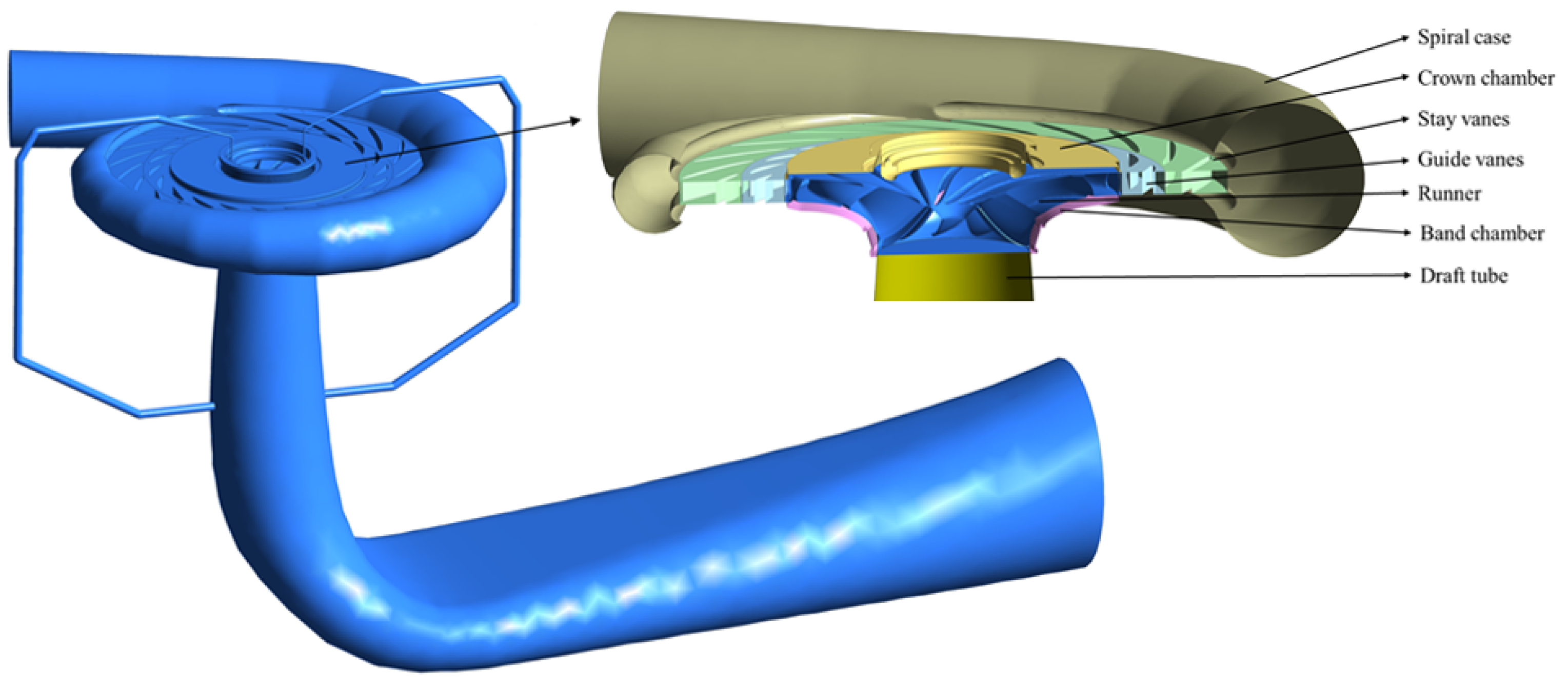
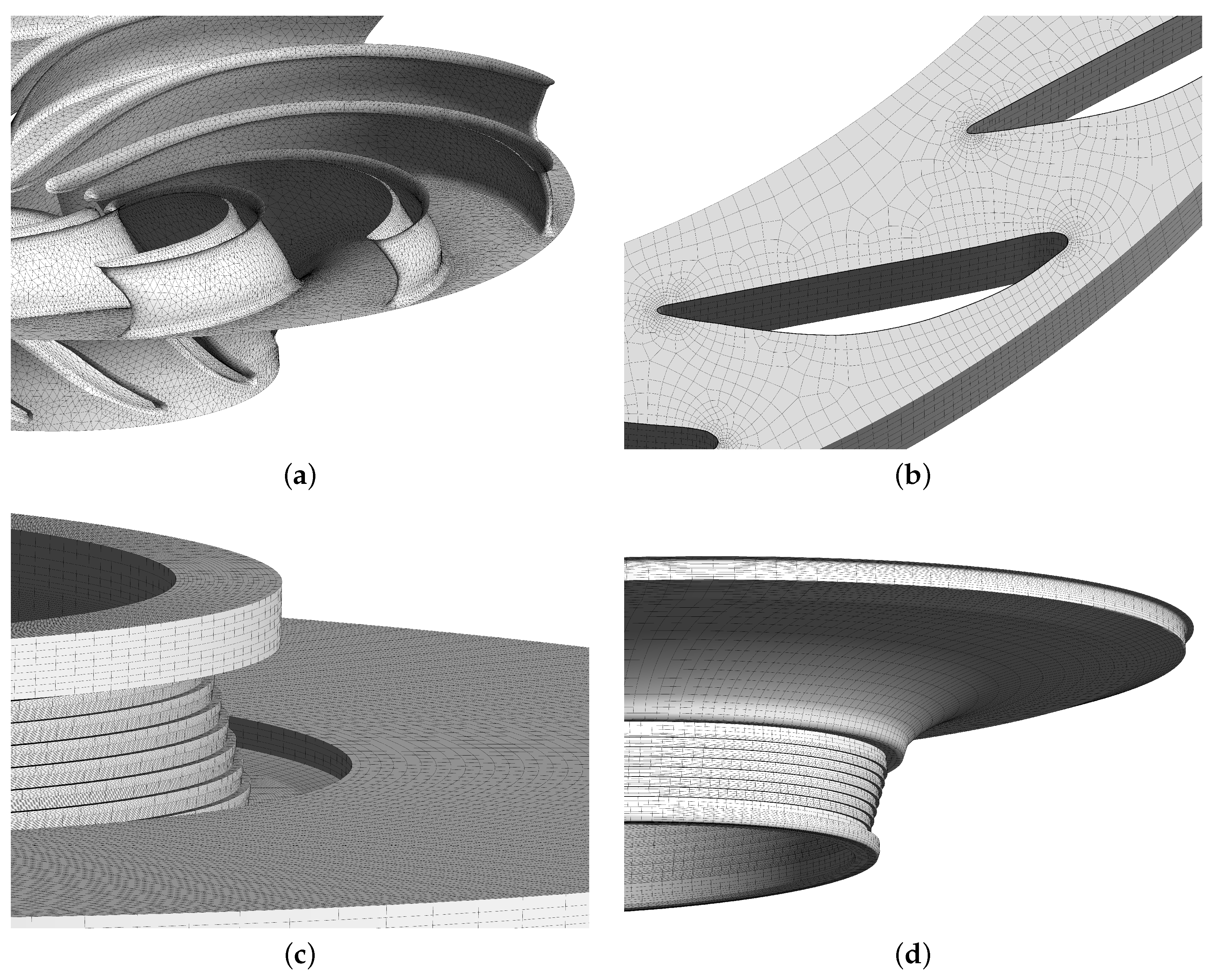



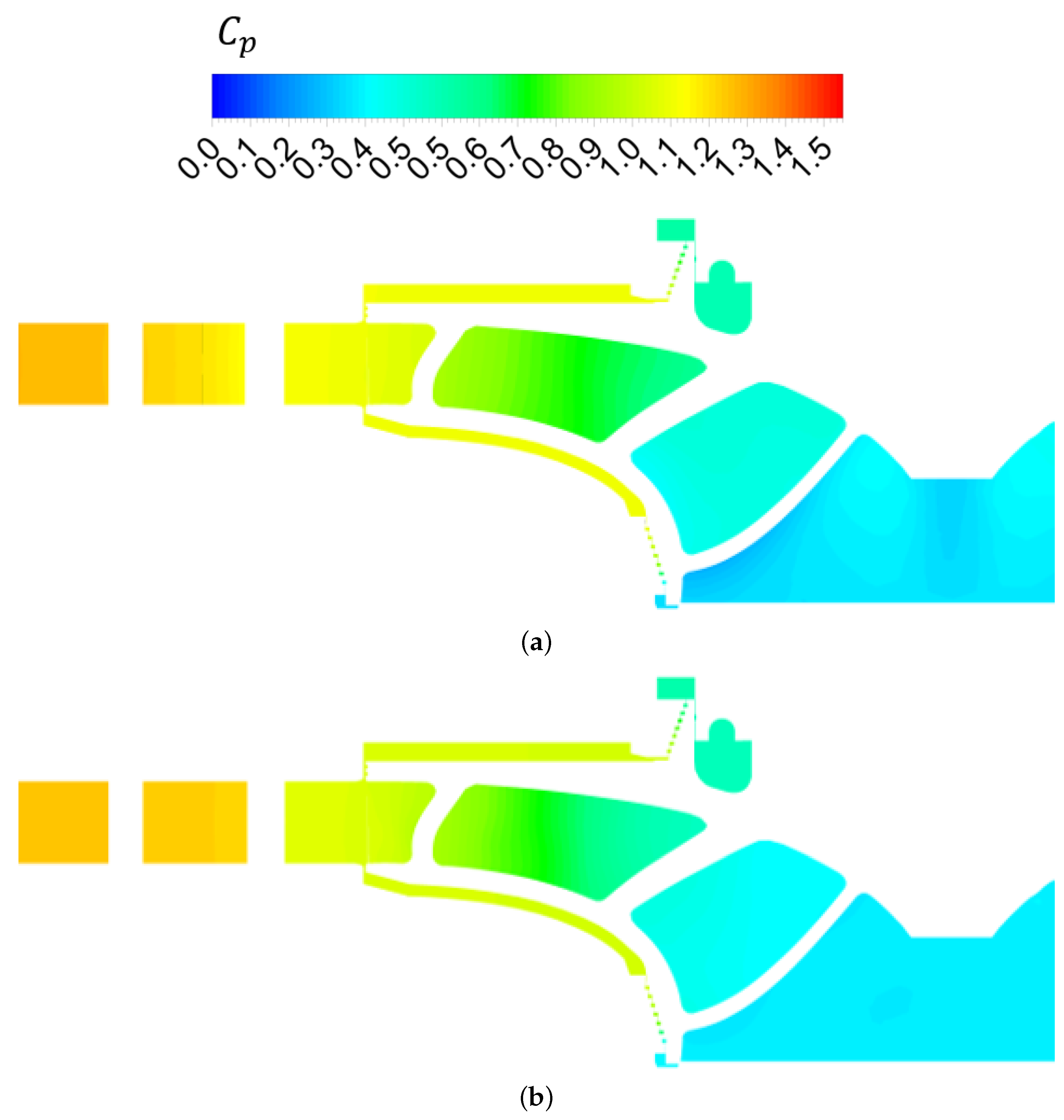
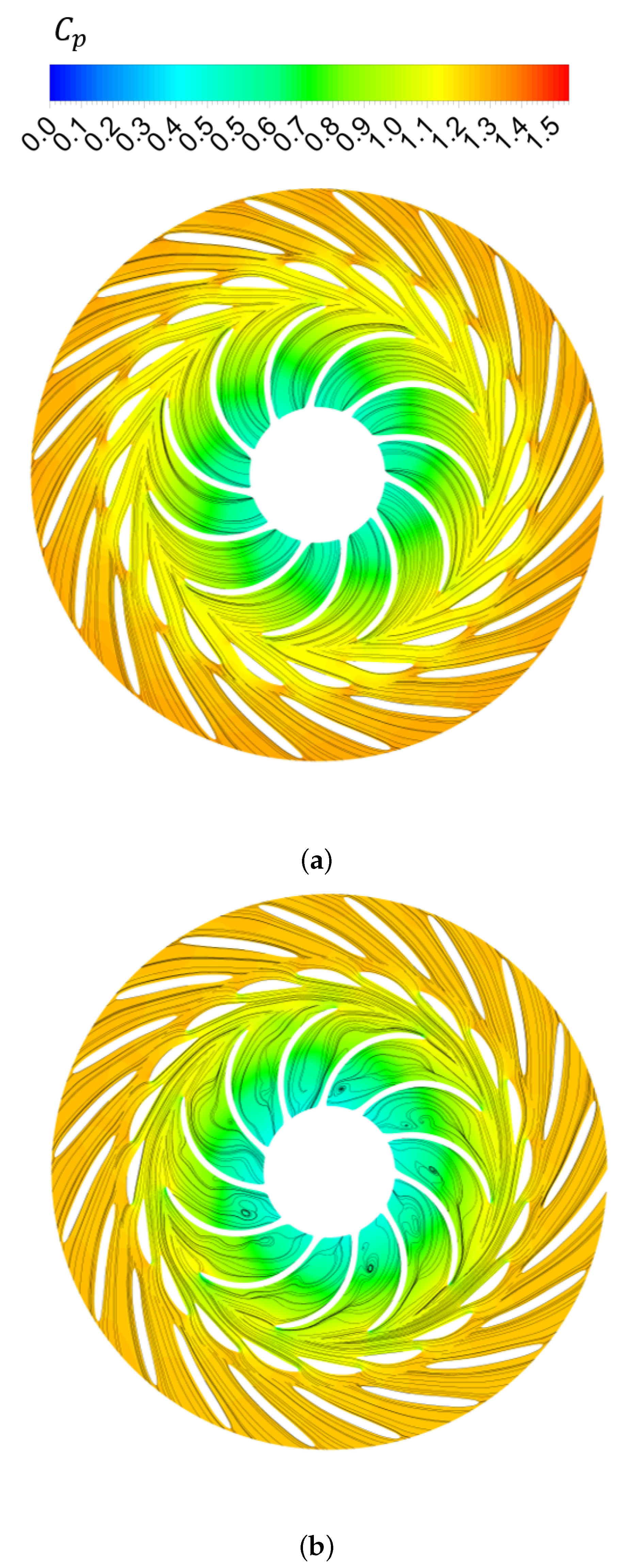
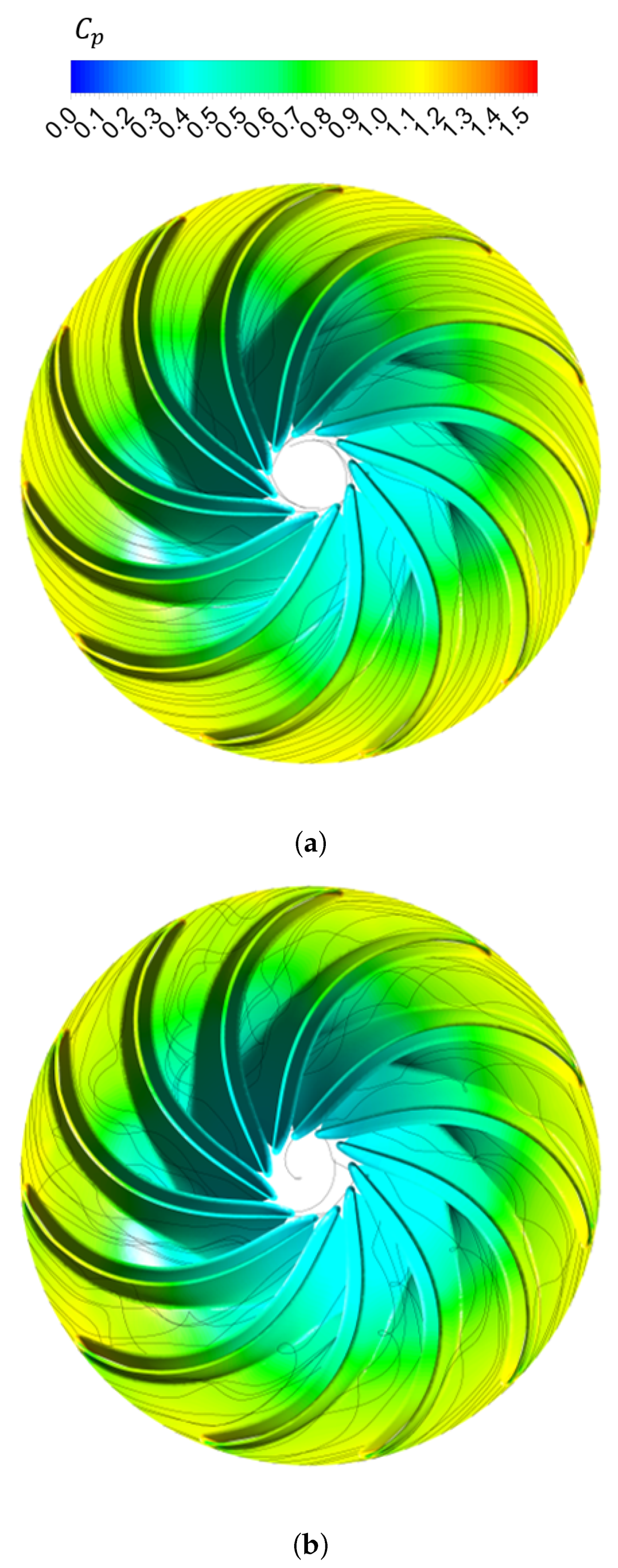
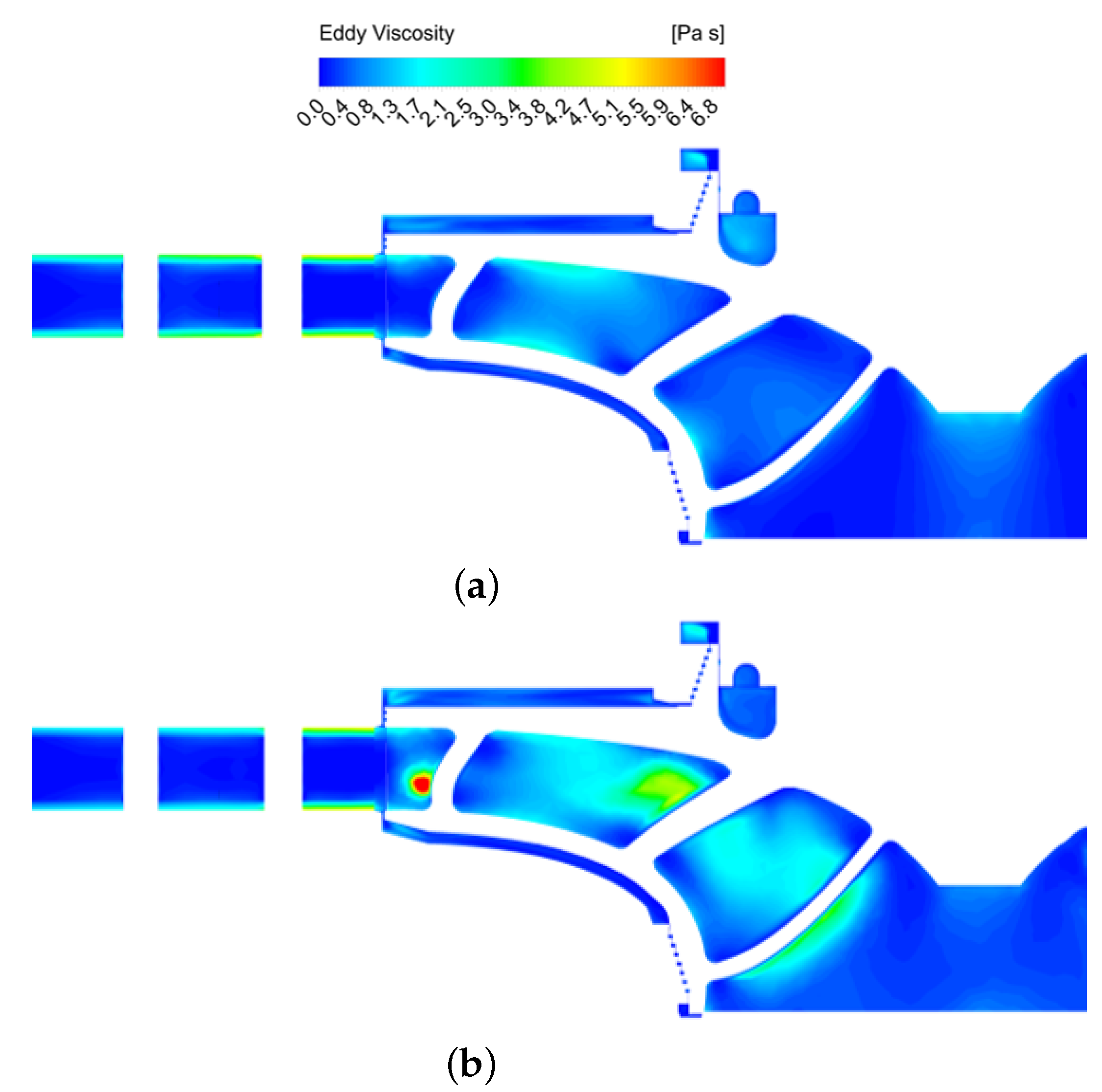

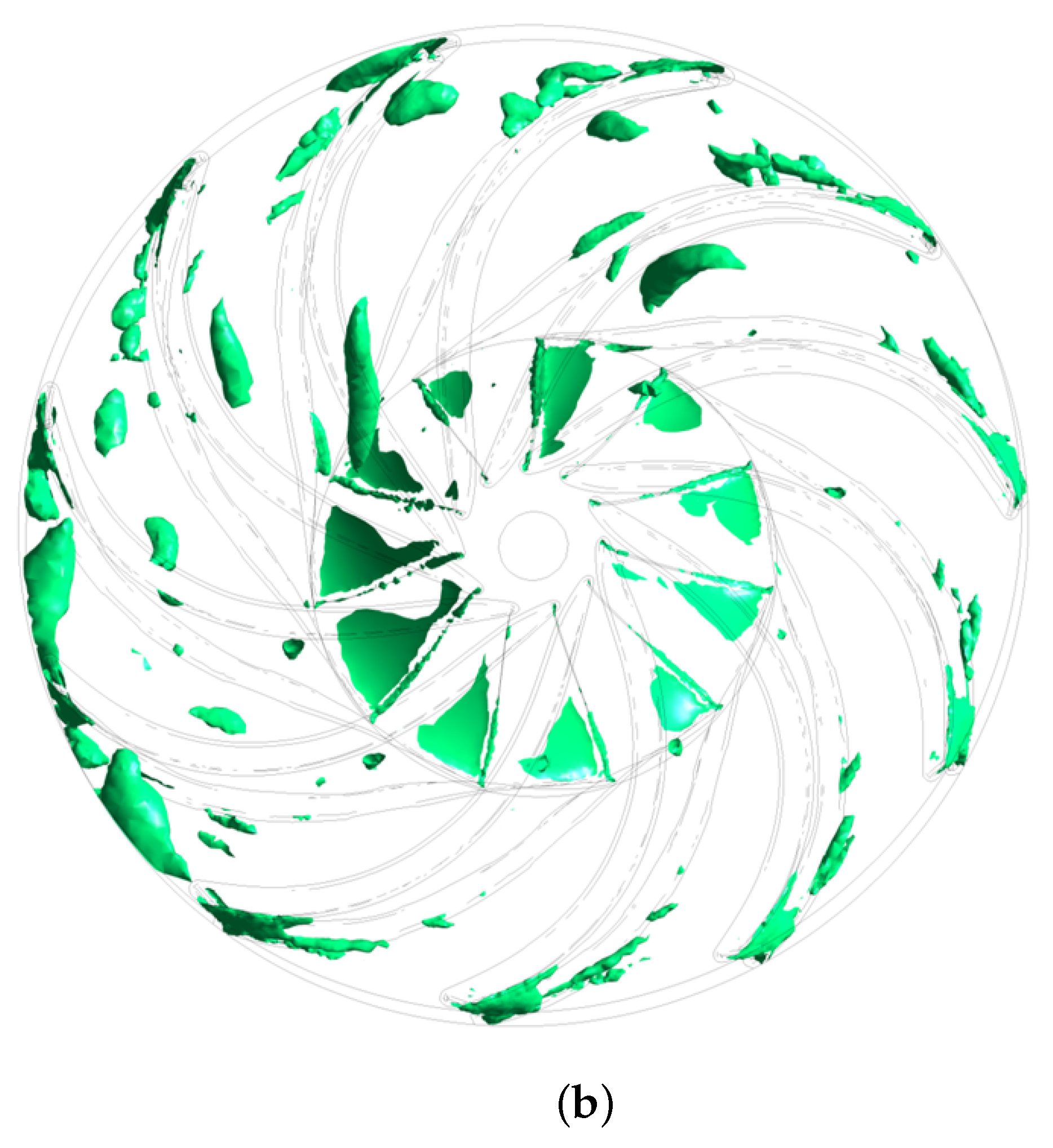

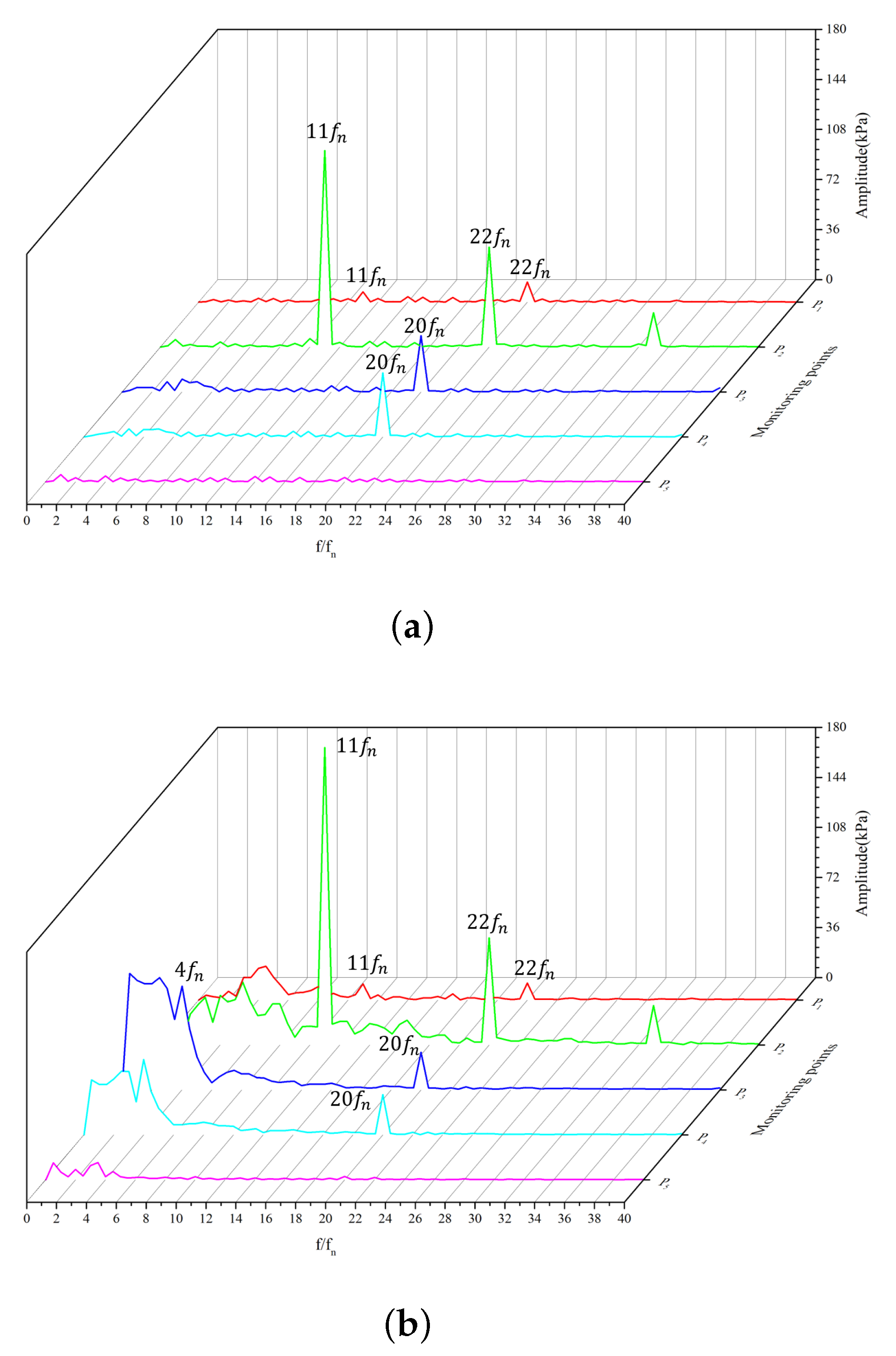

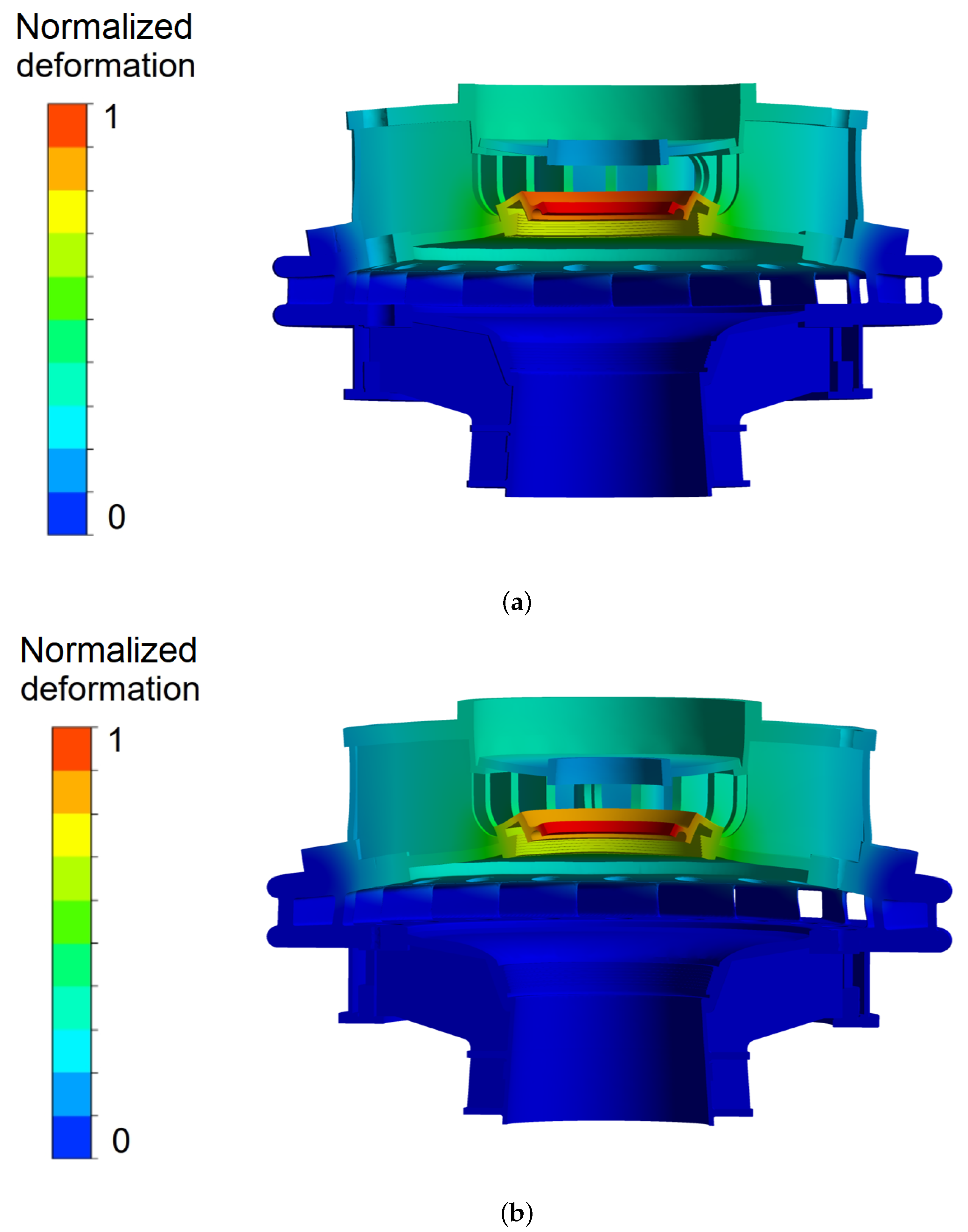

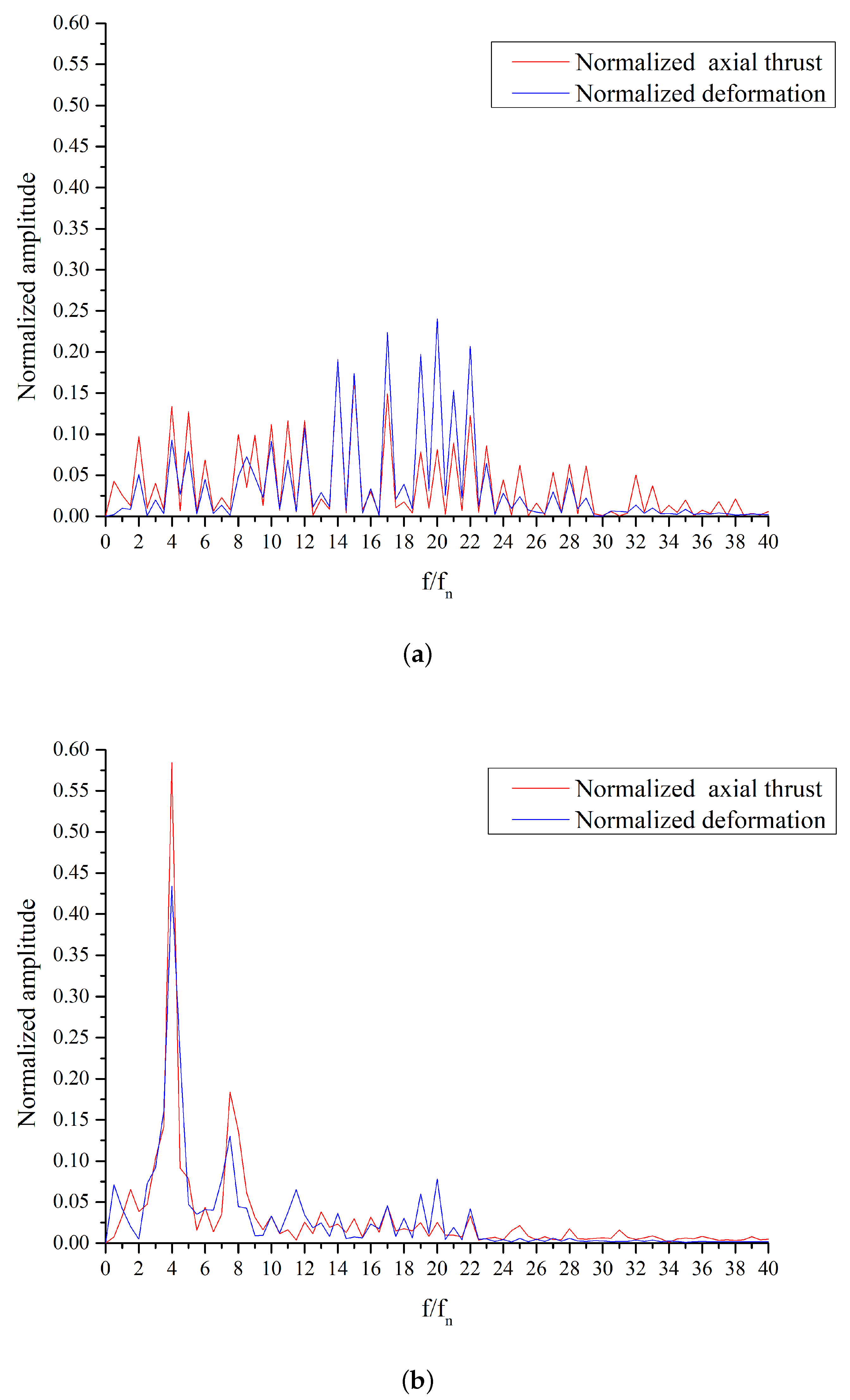


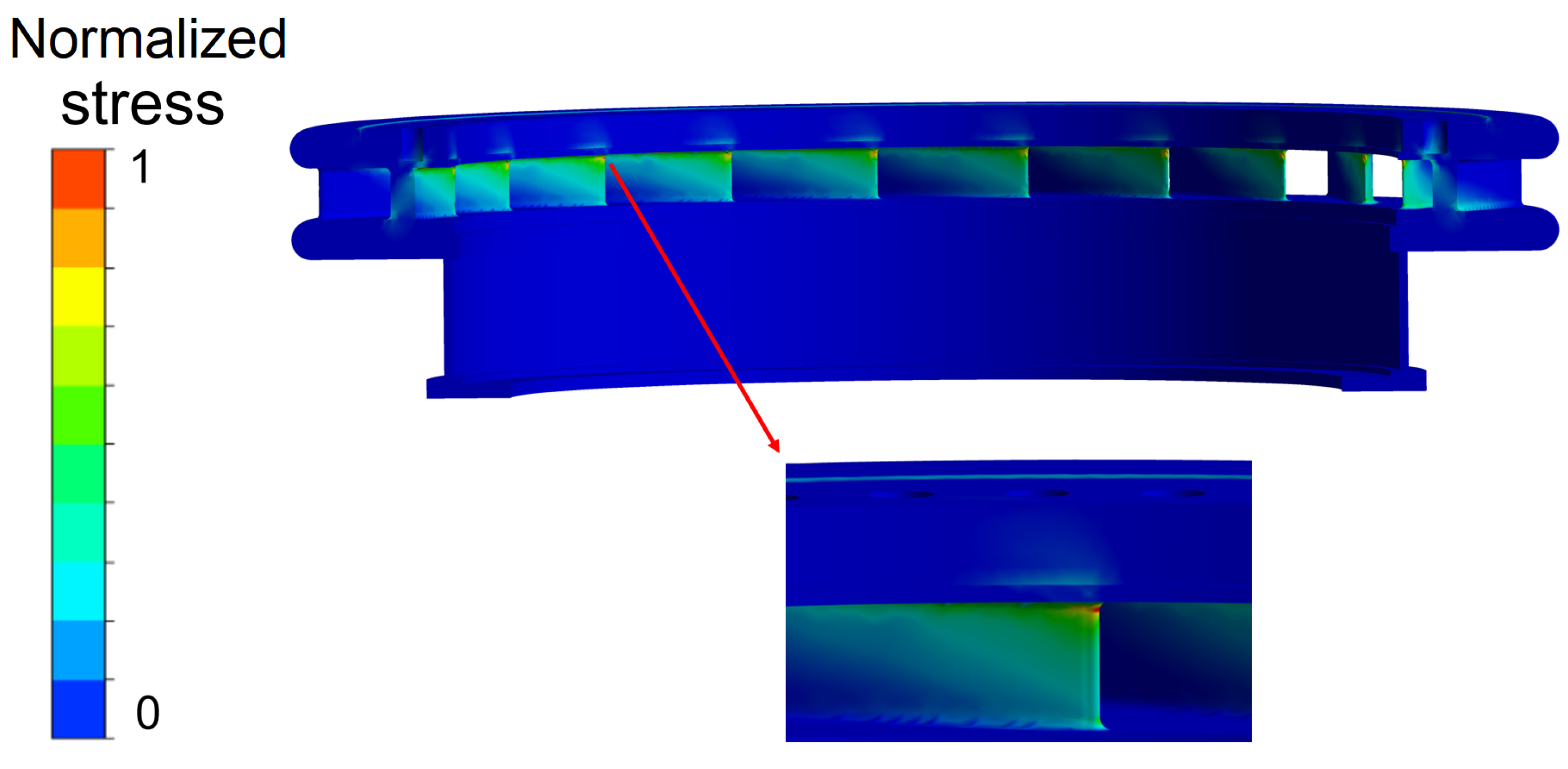
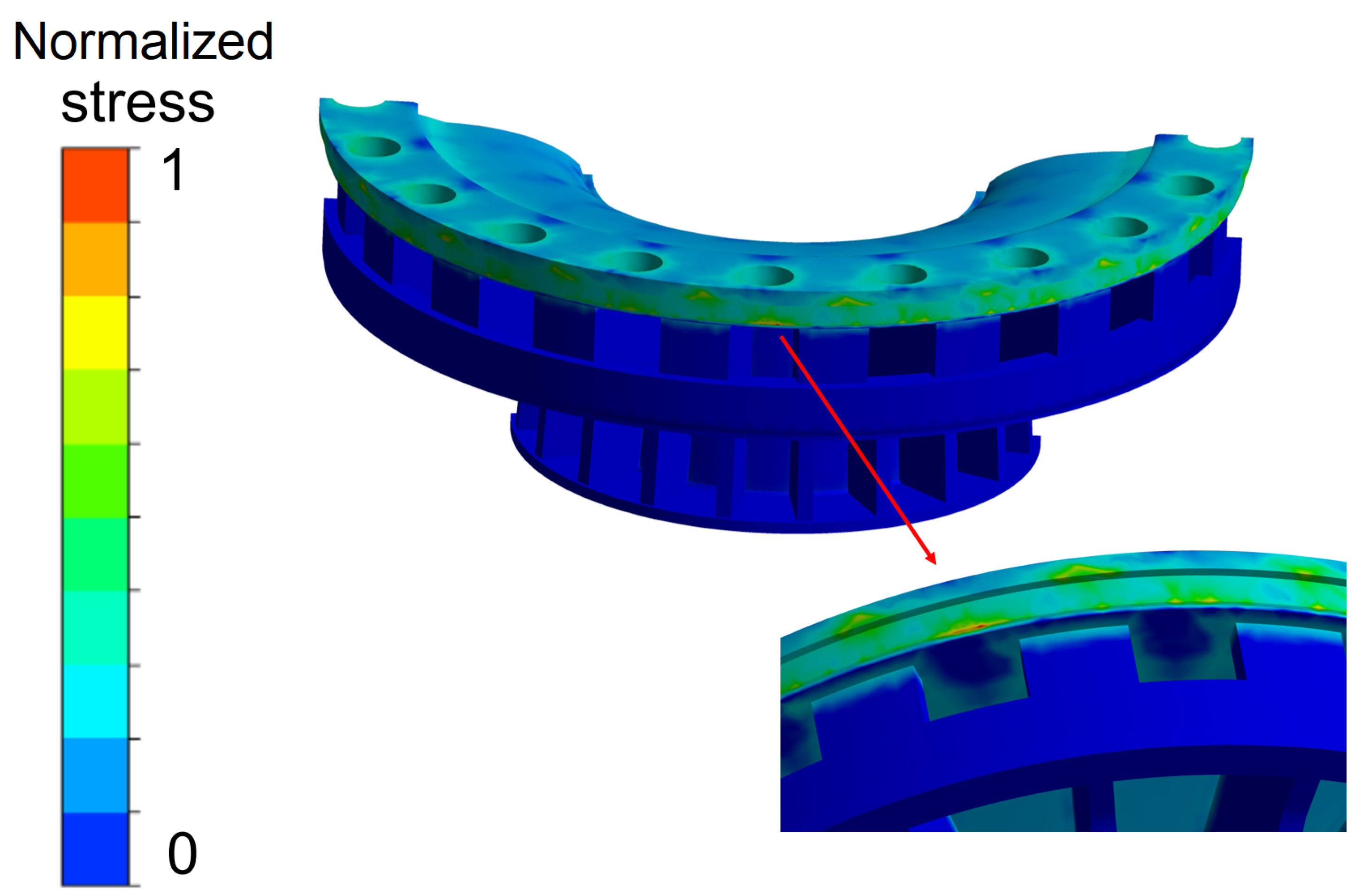
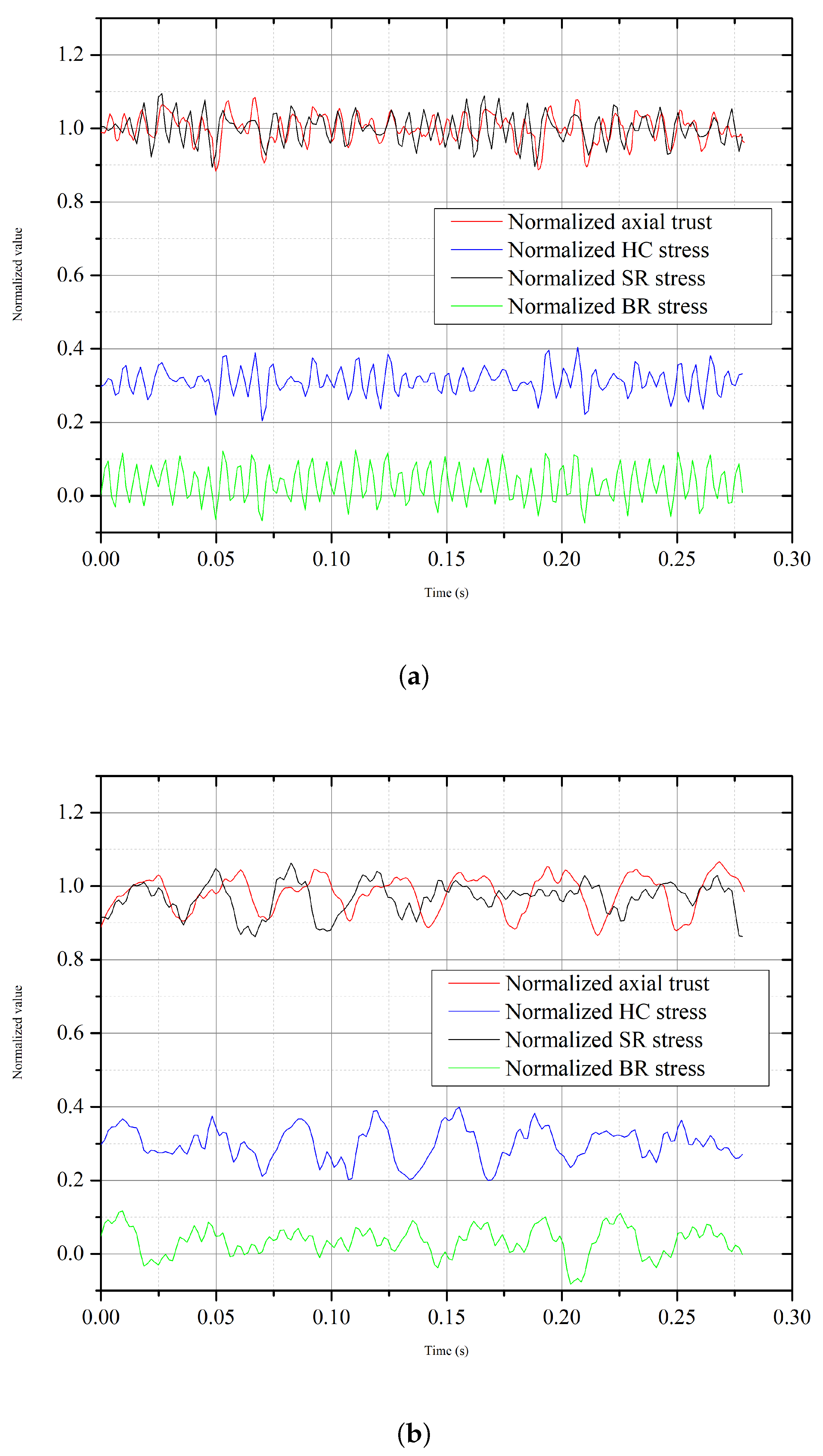
| Parameter | Unit | Value |
|---|---|---|
| Rated head | m | 545 |
| Rated rotational speed | rpm | 428.6 |
| Rated output at rated head | MW | 357.1 |
| Rated rotational frequency | Hz | 7.14 |
| Number of guide vanes | - | 20 |
| Number of stay vanes | - | 20 |
| Number of runner blades | - | 11 |
| Flow Domain | Elements () |
|---|---|
| Spiral case | 0.32 |
| Stay vanes | 0.12 |
| Guide vanes | 0.25 |
| Runner | 1.08 |
| Draft tube | 0.21 |
| Crown chamber | 0.48 |
| Band chamber | 0.10 |
| Pressure-balanced pipes | 0.40 |
| Total | 2.96 |
Disclaimer/Publisher’s Note: The statements, opinions and data contained in all publications are solely those of the individual author(s) and contributor(s) and not of MDPI and/or the editor(s). MDPI and/or the editor(s) disclaim responsibility for any injury to people or property resulting from any ideas, methods, instructions or products referred to in the content. |
© 2023 by the authors. Licensee MDPI, Basel, Switzerland. This article is an open access article distributed under the terms and conditions of the Creative Commons Attribution (CC BY) license (https://creativecommons.org/licenses/by/4.0/).
Share and Cite
Ru, S.; Zhang, S.; Zhou, K.; Huang, X.; Huang, W.; Wang, Z. Numerical Study on the Flow and Structural Characteristics of a Large High Head Prototype Pump-Turbine under Different Operating Conditions. Processes 2023, 11, 2970. https://doi.org/10.3390/pr11102970
Ru S, Zhang S, Zhou K, Huang X, Huang W, Wang Z. Numerical Study on the Flow and Structural Characteristics of a Large High Head Prototype Pump-Turbine under Different Operating Conditions. Processes. 2023; 11(10):2970. https://doi.org/10.3390/pr11102970
Chicago/Turabian StyleRu, Songnan, Shaozheng Zhang, Kaitao Zhou, Xingxing Huang, Wenlong Huang, and Zhengwei Wang. 2023. "Numerical Study on the Flow and Structural Characteristics of a Large High Head Prototype Pump-Turbine under Different Operating Conditions" Processes 11, no. 10: 2970. https://doi.org/10.3390/pr11102970






